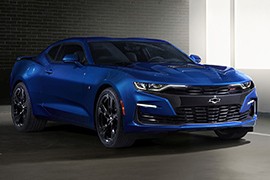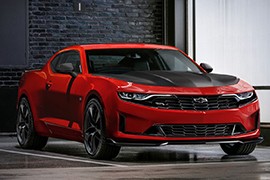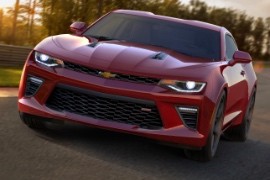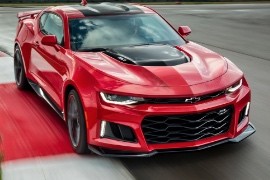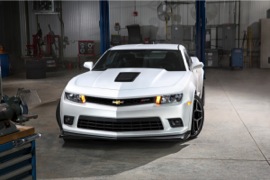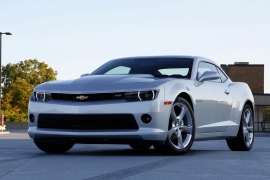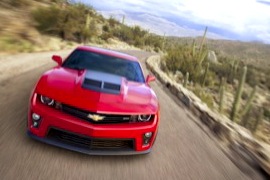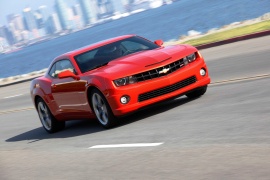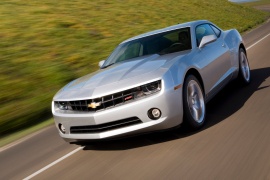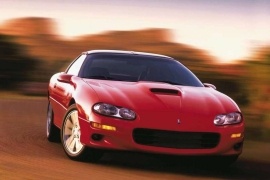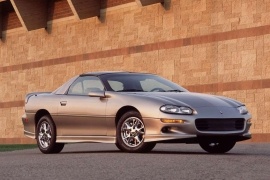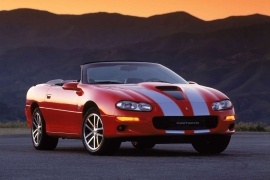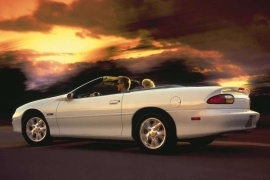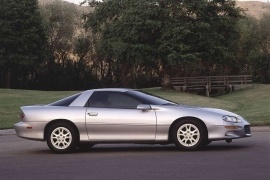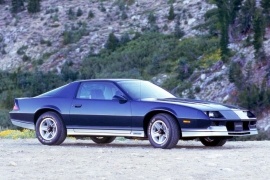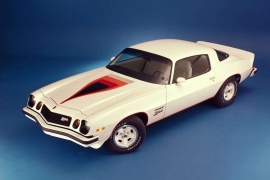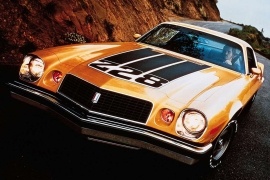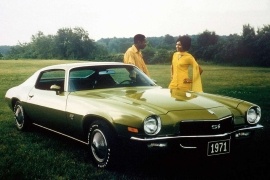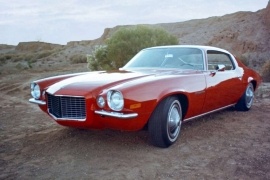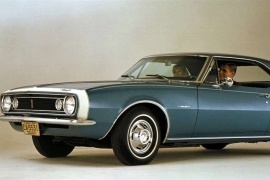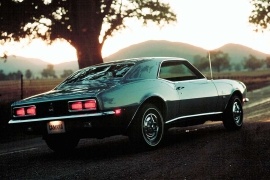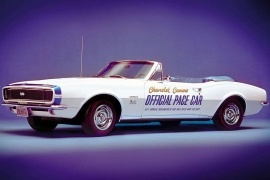CHEVROLET Camaro Models/Series Timeline, Specifications & Photos
First production year: 1967
Engines: Gasoline
Body style: Coupé (two-door)
It’s no new that the Camaro was well appreciated over the years.
For 2019, Chevrolet redesigned the Camaro and added even more technology and options to suit every customer’s needs.
The major changes for 2019 were the redesigned front and rear ends, the new LED headlamps available for every model and a new hood.
A new version was introduced, with a 2.0-liter 4-cylinder engine that developed 275 hp and 400 Nm. This engine was mostly suitable for customer buying the Camaro for the muscular, beautiful exterior design more than for the power that came with it.
The 2018 Camaro was available as a four-seat coupe or a convertible and offered no less than 6 trim levels: 1LS, 1LT, 2LT, 1SS, 2SS and ZL1.
The first two had a standard 2.0-liter turbocharged engine, but could optionally be equipped with a more powerful 3.6-liter V6 engine that developed 335 hp.
The base 1LS trim levels included standard features such as 18-inch alloys, LED running lights, a rear-view camera, keyless ignition, power-adjustable front seats, a leather-wrapped steering wheels and adjustable driving modes.
Technology wise, the Camaro was equipped with Bluetooth, OnStar emergency system, a 4G LTE Wi-Fi Connectivity and a 7-inch touchscreen with Android Auto and AppleCar play included.
CHEVROLET Camaro 2.0L 1LE VVT 6MT (275 HP)
CHEVROLET Camaro 2.0L 1LE VVT 8AT (275 HP)
CHEVROLET Camaro 2.0L VVT 6MT (275 HP)
CHEVROLET Camaro 2.0L VVT 8AT (275 HP)
CHEVROLET Camaro 3.6L V6 VVT 6MT (335 HP)
CHEVROLET Camaro 3.6L V6 VVT 8AT (335 HP)
GM took its gloves off and launched the Camaro ZL1 as a supercar beater; it was the big brawler that went on the street, picked up a fight with a Teutonic knight, and crushed him in four seconds or less.
While the retro-design conquered American car buyers' hearts and money, the memories about forgotten muscle-cars started to be heard again. This time, the modern muscle-cars are not afraid about cornering speed, and they don't share their rear suspension with a delivery van. And, perhaps, most importantly, they don't look like they were designed during lunch breaks.
The Camaro ZL1 was a special version of the well-known American coupe. At the front, it showed a bumper design like it was smiling, but it was a grin. Its narrow grille above the bumper was extended on the lower apron with a broad one where the ZL1 badge stood small in the upper left corner. From its sides, the Camaro ZL1 showed the same sculptured door panels and enlarged fenders and rear quarter panels, but in the back, there was a new wing on the trunk and four chromed exhausts under the bumper.
Inside, the sport bucket-seats upholstered in suede and contrast stitching were a promise for excellent side support. Cudos to the carmaker who took about the same consideration for the rear bench, albeit it could use some headrests.
The real transformation was under the bodywork. The ZL1 featured a supercharged V-8 that sent 650 hp to the rear wheels through a six-speed manual or, as an option, a ten-speed automatic. Its independent suspension and Brembo brakes transformed it into a track-ready car that could shake an Italian supercar's serenity. This time it wasn't all about a quarter-mile run. Its sibling, the ZL1 LE, lapped the Nurburgring track in 7m16s04," making it the fastest Camaro ever.
The sixth generation of the Chevrolet Camaro was introduced in May 2015 at Belle Isle Park in Detroit, but the sales started later that year. It was introduced with three engine choices.
The Camaro has its place in the American motoring culture. For some, it is a cult-car with its roots going back to the muscle-car era. For some decades, its name faded away until 2010 when the fifth generation arrived and stirred the pony-car market.
From the outside, the 2016 Camaro resembled the 2010 model, with a retro-design look and narrower headlights. When compared to its predecessor, the sixth generation was shorter, narrower, and smaller than its predecessor. It was also 91 kg (200 lbs) lighter. It was offered as a coupe and convertible.
Inside, the Camaro retained the dual-binnacle-style instrument cluster. It featured analog dials and an option for an 8” center screen that could provide additional information including navigation, performance, and infotainment features. The center console and the center stack were driver-focused.
Under the hood, the Camaro was available with three engine choices, starting with a four-pot turbocharged unit, a V6, and the top-of-the-range LT1, V8. The suspension featured McPherson front struts for the front and a five-link system for the rear, with Magnetic Ride Control available for the SS version. The Brembo brakes were standard for the SS and offered as an option for the other two.
The 2017 Camaro ZL1 wasn't a wolf in sheepskin but more like a cheetah under a wolf skin. It was a performance to match some supercars but it looked just like a coupe.
In the world of pony-cars, the Camaro had its place and its retro-design was a hit from the moment it showed up on the market with its first generation in 2010. But the second generation with the ZL1 version was a true-blood sports car.
From the outside, there were not too many features that could tell the difference. But a second look will show some attention to the aerodynamic details. The car had been tested over 100 hours in the wind-tunnel to adjust the already aerodynamic shape of the Camaro. There was a new hood, with carbon fiber inserts and heat extractors and additional changes that included a larger front splitter, wider front fenders, and a wing-style rear spoiler.
Since the car was designed for high-speed, the interior was fitted accordingly. It featured Recaro sport-bucket seats with great lateral support. The infotainment unit received new features that could record a lap not only as a graphic but as a video through the on-board camera. When the car was in race-mode and the manual program for the transmission was engaged, a shift-light would be shown on the head-up display.
But there is no doubt that the most important part was under the hood. A 6.2-liter supercharged engine offered 640 hp. It was mated to a standard 6-speed manual transmission or, as an option a 10-speed automatic, which was jointly developed with Ford. And the final result was a serious, fast car. And unlike some muscle-cars, the Camaro could turn and turn fast.
The 2013 Z28 was the ultimate performance Camaro launched by Chevrolet on the market. It was a track-oriented vehicle. It was lighter, faster, and louder than any other Camaro on the market.
Chevrolet had a long experience in building race-cars. It won so many races on so many categories that it is hard to say where are they more experienced. The return of the muscle car icons brought a grin on the bow-tie face. The Z28 was brought to bring a huge smile on the fans' faces.
The Camaro Z28 featured a lower front apron with a big front lip. All the fenders received a widening kit with subtle overfenders to accommodate the unusual wide wheels. The Z28 featured 305/30/ZR19 tires in all corners. While these might not be considered too wide for the rear axle, they surely were for the front. The 11 cm (4.3”) ground clearance at the front splitter was not the lowest part of the car. It was the catalytic converter, with only a 90 mm (3.5”) room above the tarmac. In the back, a big wing was fitted to the trunk-lid to put some pressure at high speeds.
Inside, the Z28 was basic, but with sport-bucket seats. As standard, it was fitted with one speaker for the seat-belt reminder, and... that was it. The air-conditioning and the stereo were optional. On the options list was the spare-wheel as well. At least it had four seats inside, but the car-maker promised that they are easy to remove.
Under the hood, there was a big, 7.0-liter V8 engine. It was mated to a standard Tremec, heavy-duty, 6-speed manual. In the back, a limited-slip differential was installed to handle the 652 Nm (481 lb-ft) of torque. The carbon-ceramic Brembo disc brakes were standard as well.
Chevrolet updated the look of the Camaro’s fifth generation in 2013 for the 2014 model year, updating the already beloved retro-design styling.
Between 2010 and 2012, Chevrolet won the sales battle against its main competitor, the Mustang. At the same time, the Dodge Challenger was way behind its schedule and struggled to survive. But the bow-tie brand lost the title in 2013 when Ford overtook it in the sales figures. But Chevrolet had expected this and slowly cooked a refresh for the lineup and took back the lead in 2013 before losing it badly in 2015 when the original pony car with the blue-oval badge reached its sixth generation, but at least it managed to stay ahead of the Challenger.
Chevrolet wanted to have a sleeker Camaro, one that could cut through the air more easily than before. In addition, it considered using aerodynamics to gain more ponies or, at least, to help cool the engine and other components. For that, the front fascia went through an update, gaining a narrower upper grille and wider lower opening. Those who ordered the RS package were delighted to see the new “halo ring” that adorned the HID headlights. After being criticized for using fake hood scoops, the carmaker decided to install a functional one for the SS version that reduced the heat in the engine bay and reduced the front axle aerodynamic lift. Finally, at the back, the 2014 Camaro sported horizontal taillights, emphasizing the car’s width. Last but not least, a small wing on the deck and a diffuser underneath the bumper completed the image of this sporty vehicle.
The interior also gained a few amenities. Besides the MyLink infotainment system fitted with a color display starting with the 2013 model year, the automaker offered additional options for the seats and trims. Chevrolet included a matte-metallic finish called Octane for the Z/28 package and added the ZL1 flat-bottom steering wheel and Recaro seats with suede inserts. These were also available for the SS and ZL1 grades. These high-bolstered bucket seats provided better side support during high-speed cornering, keeping their occupants in place. Moreover, Chevrolet bragged about offering the Camaro as a true 2+2 coupe and adopting weight-saving solutions for the vehicle, lowering the mass of the rear seats by nine pounds (4 kg.). That also helped with the car’s weight distribution, too.
Under the hood, the most significant upgrade was the addition of the seven-liter LS7 engine developed together with the Corvette Racing department. As a result, the new powerplant offered a massive 500 HP (507 PS) and 470 lb-ft. (637 Nm) of torque, which it sent through a Tremec six-speed manual to the rear wheels via a limited slip differential, resulting in a 0 to 60 MPH (0-97 kph) time of under four seconds. The rest of the engine lineup remained basically the same, with a 3.6-liter V6 for the base model and a 6.2-liter V8 for other variants.
The Camaro stormed the doors at the 2011 Chicago Auto Show with its highest performance version to that date, the ZL1.
Chevrolet Camaro was trying hard to stay ahead of the pack with the fourth generation, but its success was limited. Then, the world financial crisis came along and ruined its chances to be revived. Fortunately, GM already planned the fifth sequel of the Camaro saga, and that was a blast!
Its retro-design look with round headlights and DRLs inside the front fascia under the hood looked mean. The wide grille on the lower bumper was black regardless of the car color, and the fog-lights mounted on the outer side completed the package. A suction-type air-intake on the hood provided more air for the big, supercharged engine. On the sides, the big shoulders over the rear fenders looked muscular, like a cheetah before its jump over a pray.
Inside, the front bucket-seats featured embroiled ZL1 badges on the headrests and microfiber suede inserts. Other enhancements included a redesigned steering wheel, alloy pedals, Head-Up Display with unique performance readouts, and the "four-pack" auxiliary gauge system with boost readout. Boston Acoustics signed the premium sound system, and a rearview mirror featured a screen for the reversing camera.
But the ZL1 was impressive for its hidden parts. Chevrolet installed a 550 hp V8 under the hood, which sent power to the rear wheels via a 6-speed manual gearbox. That setup could rocket the car from zero to 100 kph (0-62 mph) in 4.1 seconds and 0.1 seconds faster when fitted with the optional 6-speed automatic with launch control. A limited-slip differential was employed to handle the huge torque, and the race-ready braking and suspension systems were fitted as standard.
GM decided to punch the Mustangs and the Challengers hard and introduced the SS version for the Camaro in 2010 and, from the quarter-mile times, it did.
There was a new muscle-car war going between the Big-Three from Detroit. The Chevrolet design department did an excellent job by taking the classic '69 Camaro and transformed it into a new vehicle. The retro-style design worked well, and soon the market was flooded by V-6 Camaros roaring around streets everywhere. But the pure petrolheads had to wait longer for the SS version.
While the marketing department did a great job by promoting the Camaro into the Transformers movie, but the true confirmation of the car's performance was the LS3-powered Camaro SS. The design department added an air-intake on the high-lifted hood and a wider lower grille in the bumper when compared to the V-6 version. A set of stripes was available, but the 19" wheels were standard. In the back, the carmaker installed a wider splitter between the two round exhausts.
Inside, Chevrolet installed nice leather seats fitted as standard and a premium Boston Acoustic sound system. But the cheap plastic used for the doors, dashboard, and center console spoiled the car's look. The retro-design used for the dials and gauges might have been looked better if they were not made with such cheap materials.
GM considered that the platform would be the winning combination and will attract the most buyers. For that, it offered the SS in two versions: manual and automatic. A 426 hp LS3 engine powered the former, while the latter featured a 400 hp L99 unit. For the automatic transmission, Chevrolet opted for an Aisin six-speed gearbox. Both versions featured independent suspension in all corners and upgraded Brembo brakes with four pistons at the front.
Already at the fifth generation, the 2009 Chevrolet Camaro had a muscular, retro design.
While the first Camaro was introduced back in 1967 as the Chevrolet’s response to the Ford Mustang, the same happened with the 2009 model.
With the Mustang having great success, GM unveiled the concept Camaro to study the customer’s reactions and determine if it was time for a new series. 8 months after releasing the concept car, the official version was announced.
An excellent performance car, the Camaro came with a V6 or a more powerful V8 engine. The V6 unit could sprint the Camaro to 100 kph in around 6 seconds, while the V8 5 seconds.
Based on a shortened and reworked version of the GM’s Zeta platform, the Camaro was equipped with an independent rear suspension and a refined handling.
The 2009 Camaro was available with 5 trim levels: LS, 1LT, 2LT, 1SS and 2SS.
While the first three were equipped with the V6 engine, the 1SS and the 2SS had the standard V8 powerplant.
Even the base model was well equipped with 18-inch black steel wheels, keyless entry, cloth upholstery, air-conditioning, cruise control and others.
The 1LT added bigger alloys and foglamps, while the 2LT added 19-inch alloys, heated exterior mirrors, leather upholstery, heated front seats and a better audio system.
The V8 powered models added specific exterior and interior styling cues besides the more performant brakes and the more powerful engine.
Other packages were available to enhance comfort, connectivity and luxury.
While the Camaro SS was the most feared version by its competitors, the Z28 was the underdog that ripped-off the heads of Mustang owners before they knew what hit them.
Even though the Z28 was not the most potent in its lineup, it was just ten ponies shy of its Super Sport brother. In straight-line acceleration, that didn't matter that much. True, the SS was better on a road-course, but for the quarter-mile run, that was less important. For the hard-core Chevy fans, the Z28 resembled the glorious second-generation Camaro that was faster than its more powerful sibling, thanks to its lighter engine. For the 1997 model, that was irrelevant since both models shared the same small-block LT1 engine.
From the outside, the Z28 featured the new headlights design with an ovoid-shaped, twin-lamps system and the turn-signals mounted lower into the bumper. The European version suffered due to the mandatory use of a front license plate, while the Americans enjoyed the view of a mouth-shaped grille.
Inside, Chevrolet installed sport bucket-seats at the front and a small bench in the rear. The dashboard was centered around the driver, with a tilted center stack. Between the front seats, a tall center console filled the space with a storage compartment, the handbrake, and the gear-stick.
Under the hood, the 5.7-liter LT1 engine provided 315 hp, ten less than the SS version. But that wasn't a problem since the LT1 was one of the easiest to tune and upgrade V-8s on the market. The engineers paired the engine with a 5-speed manual.
The 1997 Camaro SS was a bargain of its times when compared the price to the performances, and, unlike many American cars, it was good on handling as well.
The SS badge was notorious in the mid-'60s when Chevrolet installed it on its most powerful versions such as the Chevelle, the Camaro or the Nova. It didn't use it only as a marketing tool. Those vehicles were powerful and special. The 1997 Camaro SS was no exception. Chevrolet asked the SLP performance to do their magic on the Camaro Z28 and they did.
Chevrolet didn't want the Camaro SS to be subtle. It added a composite hood with a big air-intake on it and a small wing-spoiler in the back. In the rear, it added a dual stainless steel exhaust that improved both the car's look and sound. The SS needed a set of Corvette ZR1-inspired 17" light-alloy wheels fitted with fat tires to improve the car's handling.
Inside, there were not too many differences when compared to a regular Camaro Z28. Chevrolet kept the dual-color upholstery on the bucket-seat with high bolstering. A new, six-speed, manual gearbox fitted with a Hurst gear knob was fitted as standard. To emphasize the particular model, Chevrolet stuck a specific badge on the ashtray's lid, on the center console.
Under the hood, the LT4 engine from the Z28 version was tuned by SLP. They were the same team that brought more power to the Pontiac Firebird. Due to a tuned intake system, the 5.7-liter V8 provided 25 more hp than the standard Z28. Thanks to the new 6-speed manual and to an optional Torsen limited-slip differential, the SS was able to hit the quarter-mile in 14 seconds flat.
Chevrolet pulled out from its badge-bin the SS one and installed it on a car worth wearing it in 1997: the Camaro; and then added some open-top flavor.
The Super-Sport (SS) badge was well known in the mid-'60s when Chevrolet applied it on the most powerful versions of its muscle-cars such as the Nova, the Camaro, or the Chevelle. And it wasn't just a decal on the bodywork. Serious technical upgrades backed it.
Chevrolet didn't want the Camaro SS to be subtle. It added a composite hood with a big air-intake on it and a small wing-spoiler in the back. In the rear, it added a dual stainless steel exhaust that improved both the car's look and sound. The SS needed a set of Corvette ZR1-inspired 17" light-alloy wheels fitted with fat tires. Its canvas-roof was completely retractable behind the rear seats and hidden under a vinyl cover.
Inside, there were not too many differences when compared to a regular Camaro Z28. Chevrolet kept the dual-color upholstery on the bucket-seat with high bolstering. The bench was profiled for two but offered almost no legroom. A new, six-speed, manual gearbox fitted with a Hurst gear knob was fitted as standard. Chevrolet stuck a specific badge on the ashtray's lid to emphasize the particular model.
Under the hood, the LT4 engine from the Z28 version was tuned by SLP. They were the same team that brought more power to the Pontiac Firebird. Due to a tuned intake system, the 5.7-liter V8 provided 25 more ponies than the standard Z28.
The fourth generation of the Camaro was one of the most underappreciated cars on the market, even though it was an undercover Corvette.
With an LT1 engine under the hood and subtle details, the Z28 was the car that could stun and embarrass a Mustang owner before it could spell its car's name. Moreover, it was available as a coupe for the hard-core drivers or as a convertible for those who preferred a relaxed but spirited driving style.
Chevrolet changed the Camaro's look and installed a new set of headlights that were not buried under the hood. Now they were wider, rounder, more obvious. Its front grille was enlarged and reshaped. It didn't look as sharp as before, but make no mistake: it was still a hidden gem of a sports car.
Chevrolet installed a dual-color upholstery on the bucket-seat with high bolstering for the Z28 version. A new, six-speed manual gearbox was fitted as standard. The bucket seats in the back were deep, and, in theory, they allowed a couple of friends to join the drive. But in reality, there was practically zero legroom if the driver was taller than 6 ft (1.80 m).
Under the hood, Chevrolet installed the LT4 engine. It was the same, old, 5.7-liter V-8 from the Corvette, but with less power. That didn't mean that it wasn't an excellent choice for the aftermarket business and tuning companies.
The Camaro's fourth-generation might be one of the most underappreciated generations from its entire nameplate existence. Nevertheless, it was a daily pony car.
General Motors didn't want to lose the market share and hoped that a new Camaro would keep customers coming into Chevrolet's showrooms. It didn't work that well, but the car was better than most of its detractors pictured it. First of all, it was built on top of the F-Platform and featured a good balance between performance and day-to-day usability. Also, it was offered with engines for everyone's pockets.
The Camaro shared the sleek and aerodynamic look with its sibling, the Pontiac Firebird. Its sharp nose and buried headlights were unique on the market. It was only after the 1998 facelift when the car went through a facelift and received a more regular look for its lights. But the overall shape remained unchanged for the entire generation, with a very raked windshield, a short roof, and a big, sloped rear window. A short deck-lid behind completed the Camaro's sporty look.
Inside, the carmaker installed low bucket seats at the front and a small bench for two in the back, which was more often used as a trunk than to carry people. There was no headroom in there, and the legroom was limited if the front occupants were average-sized adults. For the instrument cluster, Chevrolet installed two wide dials for the speedometer and tachometer. On their right side, the engineers placed a digital odometer on an amber-lit LCD.
Apart from the special models, such as the Z28 or the SuperSport, the Camaro featured a choice of two V-6 engines paired to a standard 5-speed manual, while a 4-speed automatic was on the options list.
While the Corvette stole all the attention for its performance figures, the Camaro was the unsung hero that could offer similar performances, with the right engine in it.
GM introduced the third generation of the Camaro in 1982 to answer Ford's Mustang introduced just a few years earlier. The oil crisis was still alive in customers' minds, and the fear for another one was still present. Thus, the bow-tie brand offered the Camaro as a sporty-looking vehicle but with fuel-efficient engines. It was Chevrolet's pony-car.
Sleek, with a truly sporty look, the Camaro conquered the hearts of its customers. Even though it shared the same platform with the Pontiac Camaro, it had that something extra that made it more appealing. Maybe the dual, squared headlights or the huge curved windscreen in the back were some of the reasons why it was so attractive. Its long, frameless doors and the big taillights enhanced the sporty look of the car.
Inside, the front bucket seats covered in fabric offered good side support and comfort. Its flat, straight dash panel sported two vents in the middle and an integrated instrument panel in front of the driver. Chevrolet installed the vents controls on the upper side and the stereo on the lower area, just above the center console. The Camaro featured two seats in the back where someone could hardly crawl in and out, not to mention for how long could sit in there.
Under the hood, GM was focused more on fuel-efficient vehicles and installed a 2.5-liter inline-four paired to a four-speed manual for the base version. Chevrolet replaced the older, leaf-spring suspension with a new one, with coils in all corners. Thus, the Camaro became one of the best handling cars in its segment.
CHEVROLET Camaro 2.5L 3AT RWD (90 HP)
CHEVROLET Camaro 2.5L 4MT RWD (90 HP)
CHEVROLET Camaro 2.8L V6 3AT RWD (102 HP)
CHEVROLET Camaro 2.8L V6 4AT RWD (135 HP)
CHEVROLET Camaro 2.8L V6 4MT RWD (102 HP)
CHEVROLET Camaro 2.8L V6 5MT RWD (135 HP)
CHEVROLET Camaro 5.0L V8 3AT RWD (145 HP)
Chevrolet offered the Z28 package on the first-generation Camaro Z28 to compete in the SCCA Trans-Am Series. In 1977, the American carmaker revived that badge for the second generation.
The Camaro was one of the most famous muscle-cars. After the CAFE rules and the first oil crisis started, that era ended. But the nameplate survived on the market as an affordable sports car. The second generation of the Camaro stormed the showroom doors in 1970, but its weak engines were far from the big-block V8 engines' glorious days. But then, the Z28 showed up again.
You didn't have to be a car specialist to recognize a Z28. Apart from the badges installed on the front fenders, the car received a small update for the radiator's grille as well. Starting with 1978, the Z28 featured a power dome in the hood, with a fake air-intake. Later on, that became functional, and some additional exhaust vents were cut in the front fenders.
Inside, the Z28 was fitted as standard with the minimal requirements for a street vehicle, but there was a long list of options available. The power-windows, air-conditioning, and the stereo-cassette player were the usual items chosen by customers.
The Z28 was fitted with a 5.7-liter engine, available in a few power outputs depending on the manufacturing year and options. The standard transmission was with four-on-the-floor, while a 3-speed automatic was offered as an option. The positronic differential was part of the standard Z28 package.
By 1974 the oil crisis and the insurance premium cut through the muscle-car customers, and the carmakers had to adapt. The Z28 Camaro was one of the smartest ways to do it.
Chevrolet introduced the second generation of the Camaro in 1970. It changed its category from muscle car to pony car, competing mainly against the Mustang and the Dodge Challenger, the latter being discontinued in 1974. GM tried to keep its promise and produced the Camaro in the Z28 package, which offered the LT1 engine and a few unique features.
Chevrolet offered an option for stripes on the hood and trunk lid for starters, with broad Z28 lettering on it. The overall length increased by seven inches (178 mm) due to the larger bumpers, mandatory for the 5 mph (8 kph) rule. A unique set of alloy wheels and sport door mirrors enhanced the car's profile, while at the back, the Z28 sported dual exhausts. But the most significant improvement over its predecessor was the unibody construction of the F-body platform, which reduced the weight and improved the handling.
Inside, the carmaker installed sport bucket seats with integrated headrests. Its dashboard sported the same wide cluster extended over the instrument panel and the center stack. It still featured rear seats but with minimal legroom and headroom due to the sloped-down greenhouse.
Under the hood, Chevrolet installed a 5.7-liter V-8 engine (350- cu. in.). It was fed through a four-barrel carburetor and provided a 245 hp SAE net. It sent the power to the rear wheels via a four-speed manual gearbox with an option for a three-speed automatic (mainly for the LT version than the Z28 models) to a positronic rear differential (self-locking).
The muscle-car era was close to its end, and General Motors knew it, but it still didn't want to give up and produced a few models that could still shred their tires on the drag-strips, and not only there.
After introducing the second generation of the Camaro, it understood that it had to make its nameplate live a the same heights as its predecessor. Thus, it was almost mandatory to offer an SS version for this pony car, even though it couldn't provide it for more than a year. There were higher insurance costs and, moreover, there were new upcoming emission rules that could prevent carmakers from providing high-powered vehicles for anybody.
Featuring an almost identical shape to its siblings, the SS version of the Camaro was the sportier version. It featured a black mesh grille behind the slim bumper supported by two struts. An SS badge adorned it. The round headlights were complemented by the parking lights and the blinkers mounted under the bumper. Lower, a black apron limited the air going under the vehicle. At the back, an integrated spoiler completed the car's sporty image.
Inside, the carmaker offered a pair of black, vinyl-covered bucket seats at the front. The dashboard showed a six-dial layout, with the speedometer and the tachometer separated by the automatic-transmission indicator.
Under the hood, the 396 powerplant was a far cry from its predecessors. Due to the new measuring systems and the stricter emission regulations, the V8 engine produced an advertised 400 horses. As an option, Chevrolet also offered a 347 unit that provided 300 ponies.
Chevrolet introduced the second generation of the Camaro in 1970, and it changed the paradigm, going for a lighter vehicle rather than for bigger engines.
Even though the CAFE agreement and the new pollution regulations were not implemented yet, Chevrolet voluntarily decreased its engines' displacement. A lighter small-block led to a better handling car and, if developed with similar power output, led to a faster vehicle.
GM design department took its inspiration from the European sports cars for the second Camaro generation and designed the vehicle with a long, sloped rear window and short trunk. Depending on the trim level, the carmaker installed a rear spoiler. At the front, the pinned-out front fascia and the round headlights in squared casings looked way different than the one installed on its predecessor.
Inside, the Camaro featured sport bucket-seats mounted low on the floor to amplify the sporty sensation. The dashboard was rounded and featured a curved instrument cluster centered around the driver. On the center stack, the carmaker placed the optional radio. There was less room for the rear passengers, but the carmaker noticed that those were rarely used by anyone.
Chevrolet installed a wide range of engines that provided between 117 hp and 250 hp under the hood. GM developed a particular version, the Z28, that offered more power from the LT1, 5.7-liter engine that proved to be more powerful in real life than on paper.
CHEVROLET Camaro 3.8L V6 3AT RWD (117 HP)
CHEVROLET Camaro 3.8L V6 3MT RWD (115 HP)
CHEVROLET Camaro 4.1L 2AT RWD (155 HP)
CHEVROLET Camaro 4.1L 3AT RWD (100 HP)
CHEVROLET Camaro 4.1L 3AT RWD (110 HP)
CHEVROLET Camaro 4.1L 3AT RWD (115 HP)
CHEVROLET Camaro 4.1L 3MT RWD (100 HP)
CHEVROLET Camaro 4.1L 3MT RWD (110 HP)
CHEVROLET Camaro 4.1L 3MT RWD (115 HP)
CHEVROLET Camaro 4.1L 3MT RWD (155 HP)
CHEVROLET Camaro 4.4L V8 3AT RWD (120 HP)
CHEVROLET Camaro 5.0L V8 3AT RWD (130 HP)
CHEVROLET Camaro 5.0L V8 3AT RWD (145 HP)
CHEVROLET Camaro 5.0L V8 3AT RWD (155 HP)
CHEVROLET Camaro 5.0L V8 3AT RWD (200 HP)
CHEVROLET Camaro 5.0L V8 3MT RWD (130 HP)
CHEVROLET Camaro 5.0L V8 3MT RWD (145 HP)
CHEVROLET Camaro 5.0L V8 3MT RWD (200 HP)
CHEVROLET Camaro 5.0L V8 4MT RWD (155 HP)
CHEVROLET Camaro 5.7L V8 3AT RWD (165 HP)
CHEVROLET Camaro 5.7L V8 3AT RWD (170 HP)
CHEVROLET Camaro 5.7L V8 3AT RWD (250 HP)
CHEVROLET Camaro 5.7L V8 4MT RWD (165 HP)
The Camaro L30 was the original sleeper vehicle among its brothers, featuring similar, if not higher, performances, while its exterior didn't show it with special badges or flashy designs.
In 1967, Chevrolet introduced a unique version for the Camaro, the L30. While it resembled its SS cousin, it didn't sport any specific badge, but since it featured similar exterior packages, they were often confused. Moreover, the Chevrolet ad campaign created even more confusion between the SS and the L30. Last but not least, the two versions offered similar performances.
An L30 model looked could easily be mistaken with an SS-350 model stripped of ornamentation. A white strip adorned the front side of the car, surrounding the hood and front fenders. It was interrupted on the sides by the 327 letterings, showing the engine's displacement. It was sometimes called an SS-327, but the SS was built exclusively with the 350 engine. The grille featured the same round headlights as the rest of the range and the turn signals mounted towards the car's center, but without any badge in the middle. At the back, Chevrolet installed a dual exhaust with a crossflow muffler and side-mounted pipes.
The L30 featured a four-speed manual transmission with positraction (limited-slip differential). Due to the four-speed manual gearbox, the Camaro L30 was also known as L30/M20, where the M20 represented the gearbox. In 1967, the Camaro L30 featured a ten-bolt rear axle, but the carmaker changed it to a 12-bolt one in March. Chevrolet built a total of 10,654 L30/M20 Coupe and 1,202 L30/M20 Convertibles during its two-year production times in 1967 and 1968.
In September 1966, Chevrolet introduced the Camaro lineup in its dealership network. All of a sudden, the Mustang was not alone on the market: its contender arrived.
The battle between the Camaro and the Mustang was one of the most beautiful stories from American motoring history. Ford raised the bar in 1964, and Chevrolet answered two years later with a pony/muscle-car that didn't need a fastback version to look good. The bow-tie brand released the Camaro with a base engine that offered just 140 hp, and that was a big commercial success. Chevrolet offered the SuperSport version, or SS, as it was better known for those who asked for more power.
At the front, the '67 Camaro's front end wasn't that pined out as for the later models, and the grille was rectangular. Its two round headlights were accompanied by a set of fog lights on the grille's inner side. Last but not least, a chromed SS badge took center stage of the black grille. Unlike the models built after 1969, the 1967-1969 Camaro SS featured triangular windows on the front side of its doors. That detail was changed afterward.
Inside, there was a pair of bucket seats at the front and a regular bench in the rear. The L48 Camaro SS was offered with plenty of interior options, including a roll-cage. What was not available was the power-windows.
Under the hood, Chevrolet installed a 350 CID (5.7-liter) V8 engine. It offered almost 300 hp with a single, four-barrel carburetor. But there were so many aftermarket solutions that could easily break the 400 hp barrier, and that's what made the Camaro SS so much of a sought after.
The Muscle Car Era was at its peak when Chevrolet introduced the first-gen Camaro. It was built to fight against the Mustang, a battle that continued throughout generations.
It was clear from the start that the closed versions were preferred for drag-racing and to be modified. But for joy-ride, the Camaro Convertible SS was the one who got the aces.
With its hideaway headlights and the chromed SS badge in the middle of the black grille, the Camaro Convertible Super Sport was an eye-catcher. The fenders' flowing lines, the power-domes on the hood, and the arched rear quarter panels were distinctive elements for the vehicle. All four windows could have been opened, leaving nothing to stop the wind apart from the windshield. The '67 model featured flat caps on the wheels, while the later models featured taller ones.
Inside, there were two bucket seats for the front occupants and a bench in the rear. A nice design detail about the Camaro was that everything was placed under the dash-panel line. The instrument cluster with its two round dials, the center stack, and the floor-mounted gear-selector was all part of a new car-design culture. It was a design trend that said that from the side, the only visible thing should be the occupants and maybe the top side of the steering wheel.
Under the hood, the car was fitted with a 5.7-liter (the famous 350 engine) that produced at least 300 hp. The Camaro Convertible SS was available with either a 4-speed manual or a 3-speed auto.
CHEVROLET Camaro Super Sport Convertible 5.7L 2AT RWD (299 HP)
